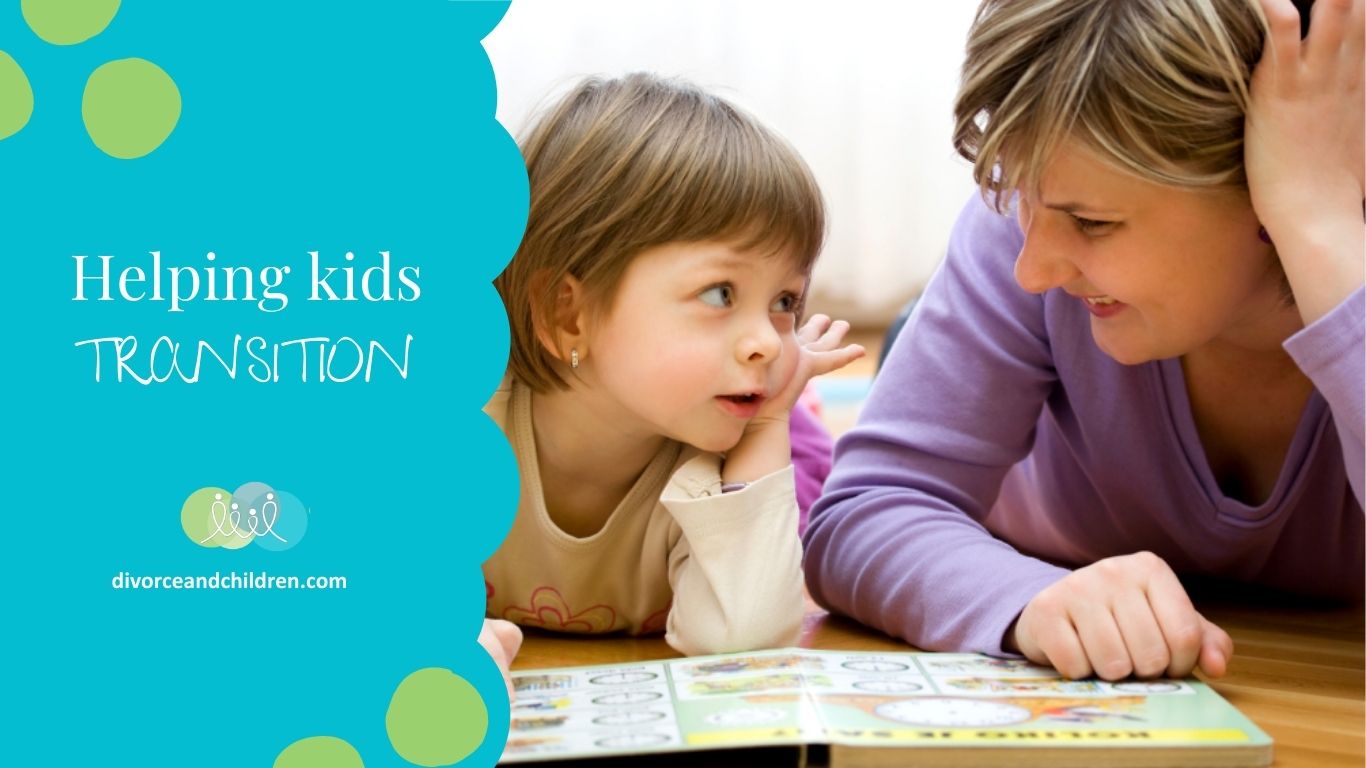Get back to calm and carry on: helping kids transition between each parent’s household

As parents, we often glide through a multitude of changes without so much as batting an eye. After all, it comes with the territory.
Lauren wakes up with a fever, so you adjust your schedule, make a couple of calls and work from home that day. Evan surprises you with a notice about baseball practice across town and the dinner you had planned turns into picking up a pizza on the way home. Sure, some of those changes are stressful, but overall most of us have cultivated the ability to roll with the punches.
WHY GOING BACK AND FORTH IS STRESSFUL FOR CHILDREN OF DIVORCE.
For children of divorce, however, living life on the fly isn’t so easy. Two homes involves juggling a schedule that may or may not be predictable, dealing with different parenting styles, different rules, different places, different people and different ways of being a family.
In addition to dealing with a multitude of differences, shifting back and forth between homes has the potential to create some serious emotional angst for kids. Johnny comes back from Dad’s bouncing off the walls and testing limits, while Melanie spirals into a never-ending whine fest after being with Mom for the weekend.
End result? You get stuck picking up the pieces and getting life back on track. The worst part—it starts all over again the next time they leave.
If you’re tired of going through the same ole, same ole when your kids come back, here’s a simple strategy you can use to get back to calm and carry on.
UNDERSTANDING THE PROBLEM
Children tend to function best when they know what to expect. For many, moving between Mom’s house and Dad’s house literally feels like transitioning between two worlds. When children don’t have an opportunity to regroup often their anxiety levels go through the roof. Without our guidance and support, kids tend to manage those feelings by acting them out (usually in ways that drive us crazy)
To offset transitional stress children need predictability and emotional space. One way you can help kids cope is by creating a consistent environment that allows children to shift gears easier.
TO MAKE IT EASIER FOR YOUR KIDS, TRY THESE SIMPLE STRATEGIES.
NOTICE WHEN, WHAT AND WHERE
Pay attention to when your kids are having a difficult time shifting gears.
For some, it may be that the anxiety hits right before leaving your home, for other kids it could be when they return after spending time with the other parent.
It can also be helpful to notice what other contributing factors are at work.
For instance, do your children react the same way every time they come back from spending time with Dad or only after they’ve been away for a weekend? Does where you pick up or drop off make a difference? Do they respond differently when Mom picks them up from school as opposed to your house?
If you discover a pattern or factors that seem to be influencing how your children respond, do your best to make adjustments in how transitions between households take place.
CREATE A RITUAL
A transition ritual involves creating a structured and predictable environment for your child every time they enter or leave your home.
Let’s say Natalie goes into meltdown mode every time Mom drops her off for the week. One way Dad could help Natalie is by choosing an activity they could do together, as soon as, she crosses his threshold. Perhaps Natalie loves to color and draw. When Natalie arrives, she and Dad could spend 30 minutes coloring together.
While coloring, they could chat about Natalie’s week with Mom and what will happen during Natalie’s week with Dad. This gives Natalie has a chance to decompress, and Dad has a way to help Natalie transition into their routine.
Keep in mind, it’s best if the activity matches your children’s personality and energy level.
For active kids you might consider going for a walk around the block, shooting hoops or playing in the backyard. Kids who are more low-key might do better engaging in an activity like drawing, putting a puzzle together, reading a book or playing a game.
For older children, mealtimes can be a meaningful way of gathering. In our family, when my bonus children were transitioning into our home, we would use a sit-down meal as a way to bring everyone together. This gave us an opportunity to talk about what we had planned for the weekend and catch up on things we missed while we were apart.
STAY CONSISTENT
In order to see the benefits of structuring transitions, it’s important to stay consistent. Be sure to plan ahead and make sure you give your kids and yourself enough time to engage in your ritual. Further, do your best to engage children, in the same way, every single time or at least until you see some significant changes in how they are handling things.
KEEP IT ENJOYABLE
Whatever you choose to do with your kids, do your best to keep it relaxing, tension-free and enjoyable. Not only will transitions smooth out, but you may also discover some treasured memories get created along the way.
How do you help your kids shift gears between households? Have an idea or comment to share? Join us over on Instagram for more co-parenting tips!
Until next time!






Good Stuff
Thank you for this article. Just wanted to let you know that I have referenced it in a recent article on my blog: http://www.thedaddywhisperer.com
http://thedaddywhisperer.com/do-your-children-live-in-two-homes-11-strategies-to-ease-the-transition-between-moms-house-and-dads-house/
Cheers.
Janice Ferguson Pugsley
Hi Janice,
thanks so much for connecting. Very grateful for the mention!
[…] McGhee, Christina. (2012). Get back to calm and carry on: helping kids transition between Mom’s house and Dad’s house. Parenting Apart. Retrieved from https://divorceandchildren.com/parentingapart/helping-kids-transition-between-households-after-di… […]
for the last month my daughter (8) is giving quite some problems, to where this morning she just refused to go to school, and created a whole drama, resulting in us getting 45min late. One of the things is that she says nobody ever listens to her.
This happens more often, and it just starts without any reason. I am not sure whether it is the transition in homes (she is already 3yrs in this situation) or that it is her age, and she just wants to misbehave
Sometimes the line between what’s related to divorce and what’s not can be a little blurry for parents. Before assuming her refusal to go to school is a “transition” issue, I’d recommend going through the process of elimination. First, if you haven’t already, I’d suggest talking to her teacher to see what’s going on at school. Is she having any problems there? Does she get along well with classmates? Has her teacher noticed any significant changes? Find out what her general attitude and mood in class are like on a day-to-day basis. Sometimes when a child is having a difficult time at school either due to academic demands or perhaps bigger issues like bullying, they may mask those problems by putting up a fuss about going to school. When kids are struggling they may feel like they’re giving us clues and when parents don’t respond, kids feel unheard. Make sure there isn’t something else contributing to your daughter’s change in behavior.
It would also be wise to check with your Ex to see if he/she has noticed any changes in their household. If not, don’t be alarmed it’s not uncommon for kids to do most of their acting out with one parent and not the other. Along with that, consider having a heart-to-heart chat with your daughter. Choose a time when both of you are calm and not pressured for time. Let her know you heard what she said about nobody listening and that how she feels is very important to you. You can go a step further by asking her if she would share with you what’s going on. What is it that you haven’t heard and how can you avoid that in the future? How can she let you know when she has something really important to say?
While it can be hard, do your best to listen to her without offering judgement or advice. What she has to say may help you figure out what’s going on and where you need to make adjustments. For more tips on being a good listener, you may want to check my article on talking to kids. Good luck and thanks for checking in.
This is a very interesting topic for me. My next book is about schedules and how kids can get easily confused. I definitely like the idea of a transition period when the kids come over. Thanks for sharing this. It is going to be very helpful for me and other families.
Thanks Angela! Good luck with your next book. Please let me know when it comes out, I’m always looking for new resources for families.
I WOULD LIKE TO NO MORE ABOUT HOW TO TAKE CARE CHILDREN AFTER DIVORCE
Hi Padmah, Thanks for stopping by! To get more information on how to help your children after divorce you may want to check out my website http://www.divorceandchildren.com. Under the left side bar click on Articles for Parents, there you will find several short helpful articles that cover some of the most pressing issues separated parents struggle with. For more specific advice, I’d recommend taking a look at my book PARENTING APART: How separated and divorced children can raise happy and secure kids. You can find out more about it here > http://bit.ly/S7t9Ta. On that page you can also preview the table of contents and access a complimentary sample chapter. Hope this helps. If you have a more specific question, feel free to send it my way.